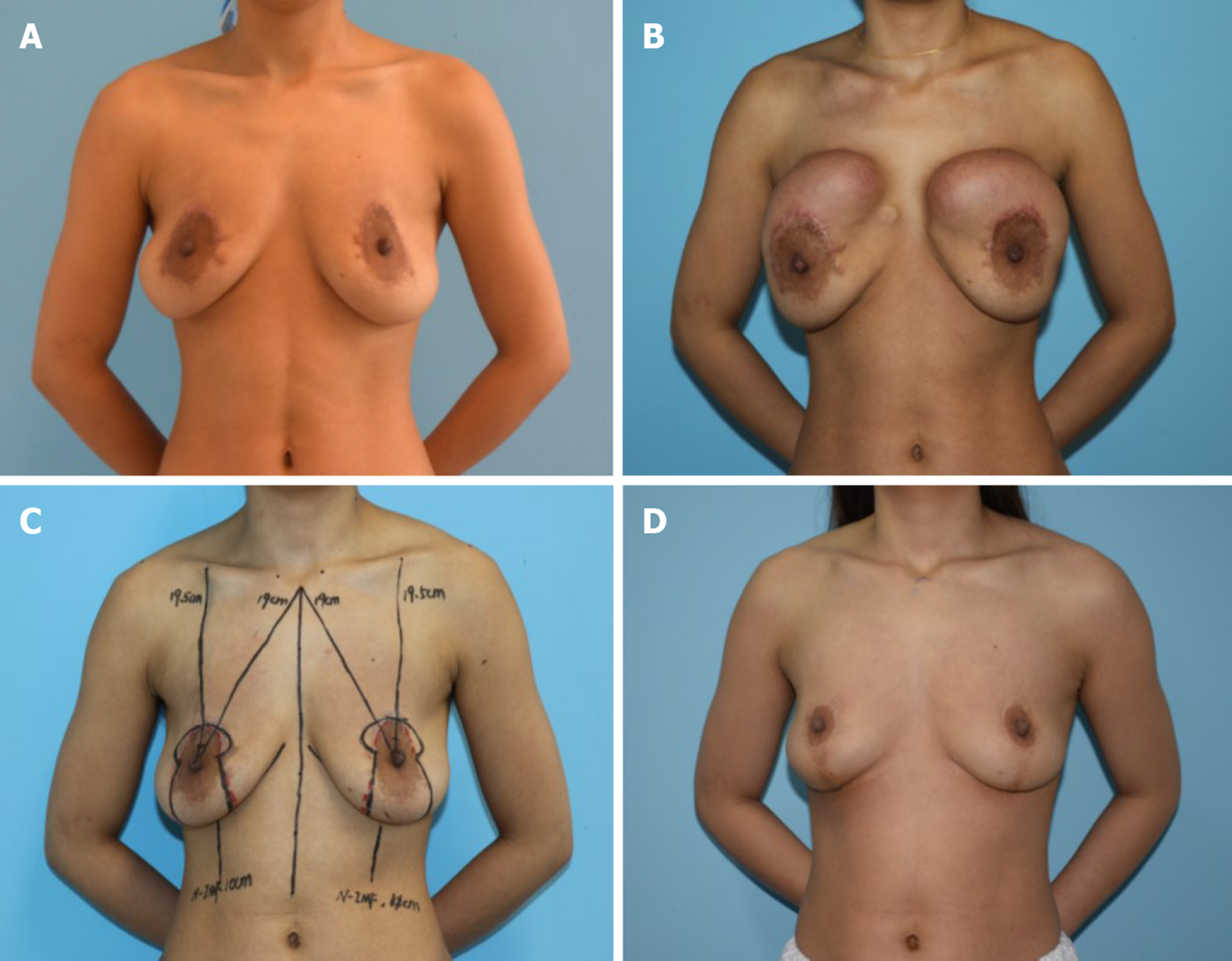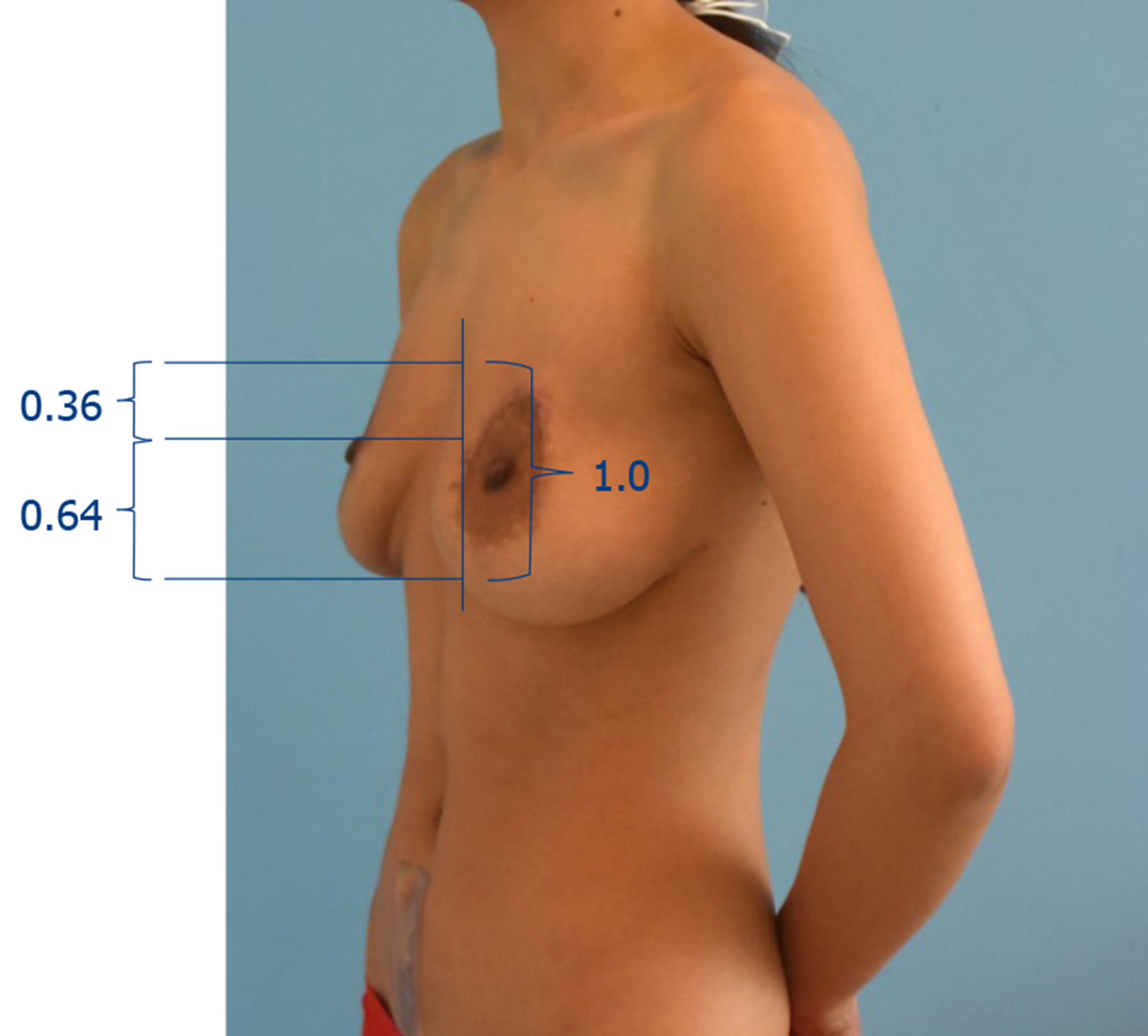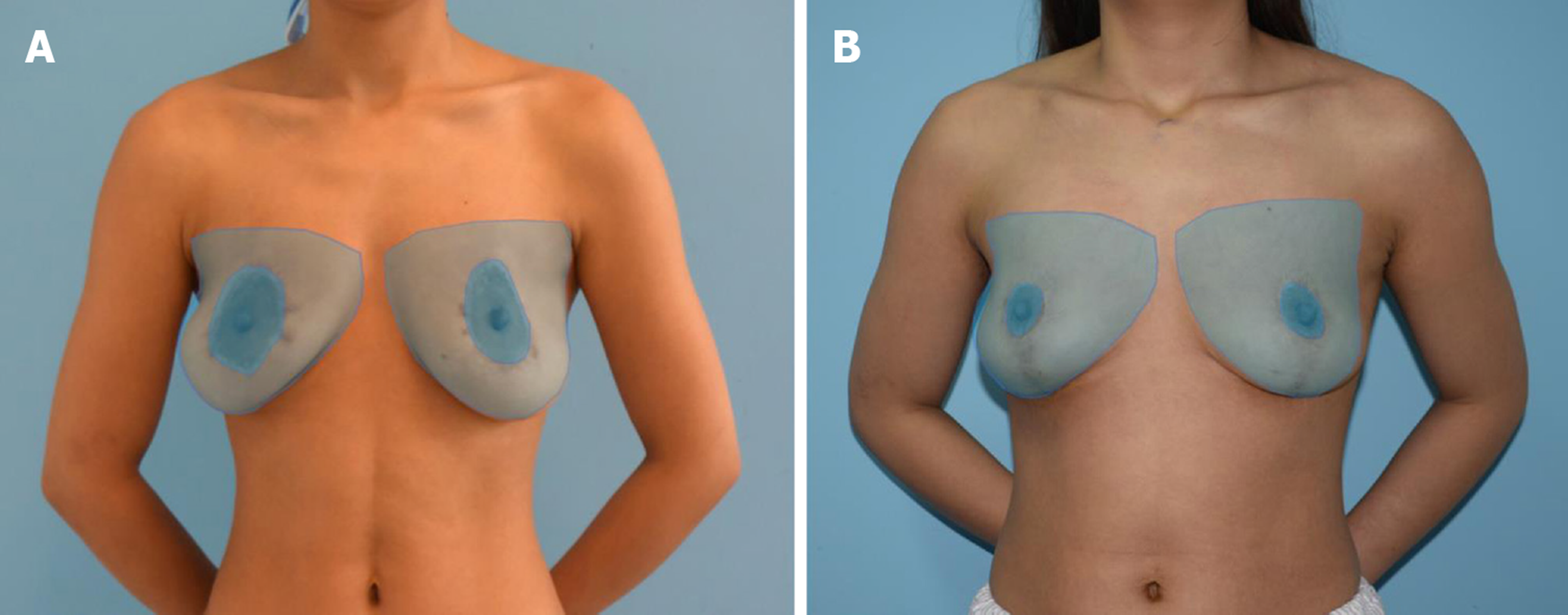Published online May 6, 2020. doi: 10.12998/wjcc.v8.i9.1674
Peer-review started: January 8, 2020
First decision: April 8, 2020
Revised: April 10, 2020
Accepted: April 15, 2020
Article in press: April 15, 2020
Published online: May 6, 2020
Processing time: 112 Days and 18.7 Hours
High-riding nipple is one of the common complications after mastopexty and breast reconstruction. However, to date, a limited number of techniques have concentrated on how to lower the high-riding nipple with enlarged areola.
This is a case report describing a combination of surgical techniques to decrease high-riding nipple. A 26-year-old woman, who previously underwent several breast operations, sought correction for high-riding nipple with enlarged areola. Expanders were used and multi-stage techniques were performed. After one year of follow-up, lowered nipple, reduced areola size, ensured nipple blood supply, and improved breast ptosis were achieved, and the patient was satisfied with the breast contour.
The proposed technique offers a feasible treatment option for postoperative nipple over-elevation combined with areola dilation.
Core tip: High-riding nipple is one of the common complications after mastopexty and breast reconstruction. However, there are very few techniques described in the current literatures on how to lower high-riding nipple with enlarged areola. This case report describes a combination of surgical techniques which offered a satisfactory correction. In this technique, expanders were used and multi-stage procedures were performed. This case offers a feasible method to solve the high-riding nipple with enlarged areola and can be used in other similar cases. At the same time, the size of the areola should be considered to assist in designing a suitable surgical plan.
- Citation: Qin F, Yu NZ, Yang E, Zeng A, Hao Y, Zhu L, Wang XJ. Expander implantation for correction of high-riding nipple with enlarged nipple-areola complex using revision mastopexy: A case report. World J Clin Cases 2020; 8(9): 1674-1678
- URL: https://www.wjgnet.com/2307-8960/full/v8/i9/1674.htm
- DOI: https://dx.doi.org/10.12998/wjcc.v8.i9.1674
The high-riding nipple deformity is not an unusual complication after mastopexy, breast reconstruction, or breast reconstruction after nipple-sparing mastectomy. In a study involving 18 patients who received nipple-sparing mastectomy and reconstruction of the irradiated breast, 55.6% of patients suffered from high-riding nipple-areola complications after 3 years[1]. Eighty-two international publications on mastopexies and breast reductions were analyzed by Swanson[2] and the result showed that 41.9% of patients had at least one overelevated nipple. The procedures using peri-areolar incisions resect a large amount of skin, which results in the high-riding nipple, areola dilatation, and hypertrophic scarring[3,4].
Lowering the high-riding nipple has always been a main challenge for breast surgeons due to the insufficient skin availability between the clavicle and nipple. A limited number of techniques have been presented. Reported approaches include raising the inframammary fold[5], reciprocal transposition flaps[6], Z-plasty flap[7], and repositioned graft[8]. However, these techniques are unable to shrink the enlarged areola. The upper pole area is the exposed attraction area of the female body, and females have no intention to leave any areola and surgical scars in this area, indicating that lowering the high-riding nipple alone is not enough, as well as the necessity of decreasing the diameter of the areola for these cases.
The present report describes a case of correction of high-riding nipple deformity with enlarged areola after breast mastopexy, which demonstrated a new strategy for similar cases. Tissue expansion of the upper pole of the breast was applied to attain free tension around circumareolar suture when areola size was reduced. This technique suggested a feasible therapeutic option for severe postoperative nipple elevation and areola dilatation.
A 26-year-old woman, who previously underwent several breast operations, was admitted to our hospital, and sought for correction for the high-riding nipple with enlarged areola. She underwent augmentation mammoplasty 5 years before her admission to our hospital. Two months before her admission to our hospital, skin-only mastopexy was performed. However, she was still unsatisfied with her breast and underwent fat grafting 1 mo before her admission. All these surgeries were performed in other institutions. These surgeries also aimed to lift the breasts and nipples, while the nipples were mistakenly placed too high, which resulted in unnatural shape accompanied by breast ptosis (Figure 1A).
The left and right areola diameters were 9 and 8 cm, respectively, including the spotted rim. Peri-areola has obvious hypertrophic scars, and ptosis was not improved. According to the most detailed classification system presented by Scott et al[9], the patient’s nipple was located at the 36th percentile of the breast’s vertical height (Figure 2). It was classified as mild nipple-areola complex (NAC) displacement, which indicated the elevated nipple at the 45th to 35th percentile.
The final diagnosis of the presented case was high-riding nipple with enlarged areola.
After understanding the risks and benefits of revision surgery, informed consent was obtained from the patient. Before the surgery, suprasternal notch–to-nipple distances were 17.5 cm on the right and 17 cm on the left, respectively. In the first stage, 300 cc kidney-shaped tissue expansions were put into the subcutaneous space at the upper pole to dilate more skin, increasing the absolute notch-to-nipple distance. We made the incision along the superior line of the areola where the old scars existed. Each expander was filled with a total of 350 mL saline water over a period of 3 mo (Figure 1B). In the second stage, the expanders were removed through the same incision and pocket (Supplemental Figure 1). Rib belts were used to prevent retraction of the expanded skin. Three months after her admission to our hospital, when the skin stopped contraction and the notch-to-nipple distance decreased to 19 cm on both sides, the third stage of revision mastopexy was undertaken. When the patient stood upright, preoperative skin mark was made considering the desired nipple location, blood supply, and minimal scarring (Figure 1C). The incision combined modified round block pattern with inverted T-incision pattern. The vascularity to the nipple-areola complex was based on the inferior pedicle. Intraoperatively, the areola was marked under maximal tension at a diameter of 40 mm. The peri-areolar and vertical segments were de-epithelialized and the vertical segment was incised through inframammary fold incision. We removed the descended tissue and built structure with the lateral and medial pillars (Supplemental Figures 2 and 3). The periareolar and vertical incisions were closed with 3-0 Quill Monoderm device and intradermal Monocryl sutures to decrease the subsequent unfavorable scarring.
The patient presented with no postoperative complication. After 1 year of her admission, both of the areola diameters were measured at 4 cm and were symmetrically placed. Most importantly, the patient was satisfied with the breast contour (Figure 1D).
Postoperative high-riding nipple with enlarged areola is an aesthetically devastating problem for patients, and is also an enormous challenge for plastic surgeons. When the high-riding nipple is combined with ptosis, it becomes even harder to be elaborated because traditional mastopexies may raise the nipple position after surgery. In the present trial, the patient underwent several breast operations before revision augmentation mastopexy. The objectives of this case included lowing the nipple, reducing the areola size, ensuring the nipple blood supply, and improving the breast ptosis. We demonstrated the successful use of expanders combined with revision mastopexy for repairing high-riding nipple with the enlarged nipple-areola complex.
Expanders were placed via the existing old scars around the areola. The increased notch-to-nipple distance before mastopexy aimed to avoid the occurrence of elevated nipple after mastopexy, which may make the nipple be placed too high to hide in the bra. At the same time, the increased notch-to-nipple distance may provide additional space to correct the enlarged areola. In addition, meticulous dissection is an important step to preserve the blood supply. The peri-areolar incision pattern and inverted T-incision pattern could minimize the length of the scar. Although this technique requires multi-stage procedures, it can successfully improve the appearance of breasts.
However, the breasts appeared flat one year after the final procedure due to the lack of enough parenchyma tissue. Another breast augmentation technique (such as implant procedure) could achieve a superior appearance, however, the patient has been already satisfied, and that technique was not therefore used. Colwell et al[10] presented a similar technique to lower the high-riding nipple, and only expander could acquire satisfactory breast contour. In the present case, enlarged areola made it more complicated, and we needed to combine modified round block pattern with inverted T-incision pattern to correct the deformity. Hence, further study should be conducted to achieve appropriate intervals between the procedures, making balance the contraction of the skin and duration of the treatment.
The most credible classification of the high-riding nipple-areola complex is based on the location of the nipple along the vertical axis of the breast[9]. According to this classification system, the present case was classified as mild NAC displacement. However, we believe that the mentioned classification is not reasonable when there is a large areola. The area of the NAC and breast was marked in the preoperative and postoperative photographs (Figure 3). ImageJ software was used, and the rates of the left and right breast preoperative areas were 23.5% and 16.5%, respectively. However, these rates postoperatively decreased to 5.1% and 5.4%, respectively, indicating the natural and reasonable nipple size.
In summary, this case suggested a feasible method to elaborate the high-riding nipple with enlarged areola, and it can be used in other similar cases as well. Additionally, with respect to the size of the areola, a new classification system for high-riding NAC is essential to further assist clinicians to design an effective surgical plan.
Manuscript source: Unsolicited manuscript
Specialty type: Medicine, research and experimental
Country/Territory of origin: China
Peer-review report’s scientific quality classification
Grade A (Excellent): 0
Grade B (Very good): B, B
Grade C (Good): 0
Grade D (Fair): 0
Grade E (Poor): 0
P-Reviewer: Vaudo G, Ziogas DE S-Editor: Wang JL L-Editor: Wang TQ E-Editor: Liu JH
| 1. | Spear SL, Shuck J, Hannan L, Albino F, Patel KM. Evaluating Long-Term Outcomes following Nipple-Sparing Mastectomy and Reconstruction in the Irradiated Breast. Plast Surg Nurs. 2017;37:66-75. [RCA] [PubMed] [DOI] [Full Text] [Cited by in Crossref: 3] [Cited by in RCA: 2] [Article Influence: 0.3] [Reference Citation Analysis (0)] |
| 2. | Swanson E. A retrospective photometric study of 82 published reports of mastopexy and breast reduction. Plast Reconstr Surg. 2011;128:1282-1301. [RCA] [PubMed] [DOI] [Full Text] [Cited by in Crossref: 72] [Cited by in RCA: 72] [Article Influence: 5.5] [Reference Citation Analysis (0)] |
| 3. | Baran CN, Peker F, Ortak T, Sensöz O, Baran NK. Unsatisfactory results of periareolar mastopexy with or without augmentation and reduction mammoplasty: enlarged areola with flattened nipple. Aesthetic Plast Surg. 2001;25:286-289. [RCA] [PubMed] [DOI] [Full Text] [Cited by in Crossref: 43] [Cited by in RCA: 30] [Article Influence: 1.3] [Reference Citation Analysis (0)] |
| 4. | Fayman MS, Potgieter E, Becker PJ. Outcome study: periareolar mammaplasty patients' perspective. Plast Reconstr Surg. 2003;111:676-684; discussion 685-687. [RCA] [PubMed] [DOI] [Full Text] [Cited by in Crossref: 18] [Cited by in RCA: 15] [Article Influence: 0.7] [Reference Citation Analysis (0)] |
| 5. | Elsahy NI. Correction of abnormally high nipples after reduction mammaplasty. Aesthetic Plast Surg. 1990;14:21-26. [RCA] [PubMed] [DOI] [Full Text] [Cited by in Crossref: 18] [Cited by in RCA: 15] [Article Influence: 0.4] [Reference Citation Analysis (0)] |
| 6. | Spear SL, Albino FP, Al-Attar A. Repairing the high-riding nipple with reciprocal transposition flaps. Plast Reconstr Surg. 2013;131:687-689. [RCA] [PubMed] [DOI] [Full Text] [Cited by in Crossref: 17] [Cited by in RCA: 17] [Article Influence: 1.4] [Reference Citation Analysis (0)] |
| 7. | Frenkiel BA, Pacifico MD, Ritz M, Southwick G. A solution to the high-riding nipple-areola complex. Aesthetic Plast Surg. 2010;34:525-527. [RCA] [PubMed] [DOI] [Full Text] [Cited by in Crossref: 25] [Cited by in RCA: 21] [Article Influence: 1.4] [Reference Citation Analysis (0)] |
| 8. | Ali S, Jaffe W, Howcroft A. A simple method of resiting the malpositioned nipple. Br J Plast Surg. 1997;50:470. [RCA] [PubMed] [DOI] [Full Text] [Cited by in Crossref: 7] [Cited by in RCA: 7] [Article Influence: 0.3] [Reference Citation Analysis (0)] |
| 9. | Spear SL, Albino FP, Al-Attar A. Classification and management of the postoperative, high-riding nipple. Plast Reconstr Surg. 2013;131:1413-1421. [RCA] [PubMed] [DOI] [Full Text] [Cited by in Crossref: 22] [Cited by in RCA: 24] [Article Influence: 2.0] [Reference Citation Analysis (0)] |
| 10. | Colwell AS, May JW, Slavin SA. Lowering the postoperative high-riding nipple. Plast Reconstr Surg. 2007;120:596-599. [RCA] [PubMed] [DOI] [Full Text] [Cited by in Crossref: 19] [Cited by in RCA: 13] [Article Influence: 0.7] [Reference Citation Analysis (0)] |











